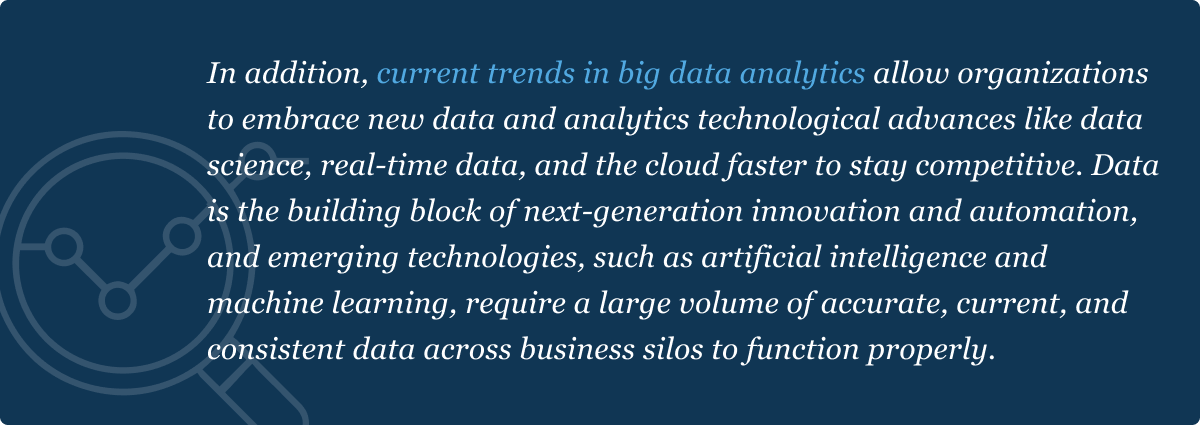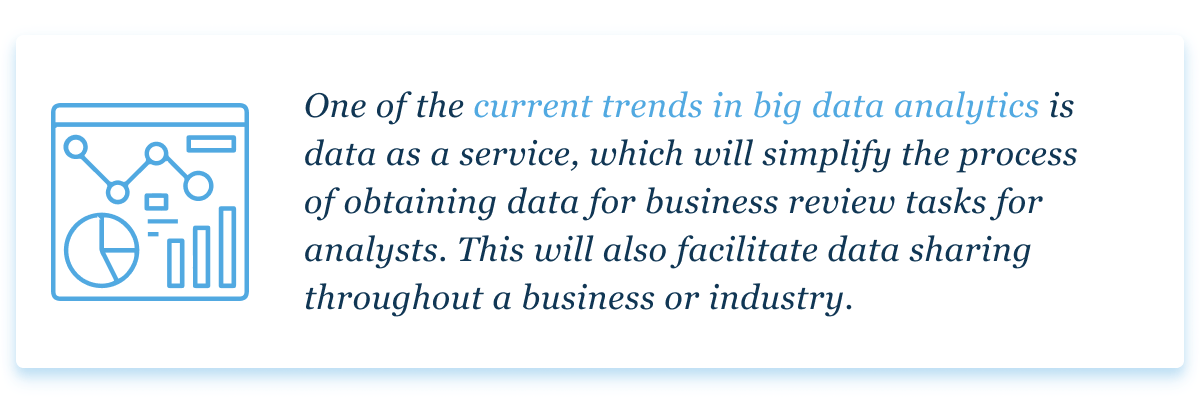There is no doubt that we produce more data in a day than we did in decades of history. We most likely don’t even realize that we produce such a large amount of data simply by browsing on the Internet, so you will be surprised. Keep an eye out for the future trends in Big data analytics and you won’t be caught off guard by future technologies.
Over the past decade, global data has been growing exponentially, and it continues to do so today. It is mainly aggregated via the internet, including social networks, web search requests, text messages, and media files. IoT devices and sensors also contribute huge amounts of data propelling Big data analytics trends.
Throughout various industries, Big data has evolved significantly since it first entered the technical scene in the early 2000s. As Big data has become more prevalent, companies must hire experts in data analytics, capable of handling complex data processing to keep up with the latest trends in Big data analytics.
Data fabric
On-premises and cloud environments are supported by data fabrics, which provide consistent functionality across a variety of endpoints. Using Data Fabric, organizations can simplify and integrate data storage across cloud and on-premises environments, providing access to and sharing of data in a distributed environment to drive digital transformation & new trends in Big data analytics.
Through a data fabric architecture, organizations are able to store and retrieve information across distributed on-premises, cloud, and hybrid infrastructures. Enterprises can utilize data fabrics in an ever-changing regulatory environment, while ensuring the right data is securely provided in an environment where data and analytics technology is constantly evolving.

As opposed to being generated by real-world events, synthetic data is information created artificially. Synthetic data is produced algorithmically, and it can be used as a substitute for production or operational data as well as to validate mathematical models and, more often than not, to train machine learning algorithms.
As of 2022, more attention is being paid to training machine learning algorithms using synthetic data sets, which are simulations generated by computers that provide a wide variety of different and anonymous training data for machine learning algorithms. In order to ensure a close resemblance to the genuine data, various techniques are used to create the anonymized data, such as general conflicting networks and simulators.

Source: Unsplash
Although synthetic data concepts have been around for decades, they did not gain serious commercial adoption until the mid-2000s in the autonomous vehicle industry. It is no surprise that synthetic data’s use in autonomous vehicles began there. It is often the sector that is catalyst for the development of foundational technologies like synthetic data because it attracts more machine learning talent and investment dollars than any other commercial application of AI, further accelerating Big data analytics and the future of marketing and sales.
AI developers can improve their models’ performance and robustness by using synthetic data sets. In order to train and develop machine learning and artificial intelligence (AI), data scientists have developed efficient methods for producing high-quality synthetic data that would be helpful to companies that need large quantities of data.
Data as a service
Data was traditionally stored in data stores, which were designed for particular applications to access, however, when SaaS (software as a service) gained popularity, DaaS was a relatively new concept. As with Software-as-a-Service applications, Data as a Service uses cloud technology to provide users and applications with on-demand access to information, regardless of where the users or applications are located.

In spite of the popularity of SaaS for more than a decade, DaaS has only recently begun to gain broad acceptance. The reason for this is that generic cloud computing services were not originally built to handle massive data workloads; instead, they were intended to host applications and store data (instead of integrating, analyzing, and processing data).
Earlier in the life of cloud computing, when bandwidth was often limited, processing large data sets via the network was also challenging. Nonetheless, DaaS is just as practical and beneficial as SaaS today, thanks to the availability of low-cost cloud storage and bandwidth, combined with cloud-based platforms designed specifically for managing and processing large amounts of data quickly and efficiently.
Active Metadata
The key to maximizing a modern data stack lies in the enrichment of active metadata by machine learning, human interaction, and process output. In modern data science procedures, there are several different classifications of data, and metadata is the one that informs users about the data. To ensure that Big data is properly interpreted and can be effectively leveraged to deliver results, a metadata management strategy is essential.

Source: Unsplash
A good data management strategy for Big data requires good metadata management from collection to archiving to processing to cleaning. As technologies like IoT, cloud computing, etc., advance, this will be useful in formulating digital strategies, monitoring in the purposeful use of data, & identifying the sources of information used in analyses to accelerate the Big data analytics future scope. Data governance would be enhanced by the use of active metadata, which are available in a variety of forms.
Edge Computing
This term describes the process of running a process on a local system, such as the system of a user, an IoT device or a server, and moving that process there. Edge computing allows data to be processed at the edge of a network, reducing the number of long-distance connections between a server and a customer, making it a major trend in Big data analytics.
This enhances Data Streaming, such as real-time data streaming and processing without causing latency; devices respond immediately as a result. Computing at the edge is efficient because it consumes less bandwidth and reduces an organization’s development costs. It also enables remote software to run more efficiently.
Many companies use edge computing to save money alone, so cost savings are often the driving force for their deployment. In organizations initially embraced the cloud, bandwidth costs may have been higher than anticipated, and if they are looking for a less expensive alternative, edge computing might be a good fit.

Source: Unsplash
In recent years, edge computing has become increasingly popular as a way to process and store data faster, which can allow companies to create more efficient real-time applications. The facial recognition algorithm would have to be run through a cloud-based service if a smartphone scanned a person’s face for facial recognition before edge computing was invented, which would take a lot of time and effort.
Hybrid clouds
With the orchestration of two interfaces, a cloud computing system combines a private cloud on-premises with a public cloud from a third party. With hybrid cloud deployment, processes are moved between private and public clouds, which allows for great flexibility and more data deployment options. For an organization to be adaptable to the aspired public cloud, it needs a private cloud.
This requires building a data center, which includes servers, storage, a LAN, and load balancers. VMs and containers must be supported by a virtualization layer or hypervisor. A private cloud software layer must also be installed, enabling instances to transfer data between the public and private clouds through the implementation of software.
A hybrid cloud setup uses traditional systems as well as the latest cloud technology, without a full commitment to a specific vendor, and adjusts the infrastructure accordingly. Businesses work with a variety of types of data in disparate environments and adjust their infrastructure accordingly. The organization can migrate workloads between its traditional infrastructure and the public cloud at any time.

Source: Unsplash
Data center infrastructure is owned and operated by an organization with a private cloud, which is associated with significant capital expenditures and fixed costs. In contrast, public cloud resources and services are considered variable and operational expenses. Hybrid cloud users can choose to run workloads in the most cost-effective environment.
Data service layer
An organization’s data service level is critical to providing data to customers within and across organizations. Real-time service levels enable end-users to interact with data in real-time or near-real-time changing the Big data analytics future scope.
In addition to providing low-cost storage to store large quantities of raw data, the data lakehouse system implements the metadata layer above the store in order to structure data and improve data management capabilities similar to a data warehouse. A single system lets multiple teams access all company data for a variety of projects, such as machine learning, data science, and business intelligence, using one system.
Data mesh
An enterprise data fabric is a holistic approach for connecting all data within an organization, regardless of its location, and making it accessible on demand. A data mesh, on the other hand, is an architectural approach similar to and supportive of that approach. With a data mesh, information about creating, storing, and sharing data is domain-specific and applicable across multiple domains on a distributed architecture.

Source: Unsplash
Using data mesh approaches is a great way for businesses to democratize both data access and data management by treating data as a product, organized and governed by experts. Taking a data mesh approach is a great way to increase scalability of the data warehouse model as well as democratize both data access and data management.
Natural language processing
Among the many applications of artificial intelligence, Natural Language Processing (NLP) enables computers and humans to communicate effectively. It is a type of artificial intelligence that aims to read and decode human language and create meanings. The majority of the software developed for natural language processing is based on machine learning.

Source: Unsplash
By applying grammar rules, algorithms can recognize and extract the necessary data from each sentence in Natural Language Processing. The main techniques used in natural language processing are syntactic and semantic analysis. A syntactic analysis takes care of sentences and grammatical problems, whereas a semantic analysis analyzes the meaning of the text or data.
XOps
A key objective of XOps (data, machine learning, model, platform) is to optimize efficiency and achieve economies of scale. XOps is achieved by adopting DevOps best practices. This will reduce technology, process replication, and automation, ensuring efficiency, reusability, and repeatability. These innovations would allow prototypes to be scaled, with flexible design and agile orchestration of governed systems.
A growing number of algorithms for solving specific business problems is being deployed as AI continues to increase, so organizations will need multiple algorithms for attacking new challenges. By removing organizational silos to facilitate greater collaboration between software engineers, data scientists and IT staff, companies can effectively implement ModelOps and ensure it becomes an integral part of AI development and deployment.
Summary
As the name implies, Big data refers to a large amount of information that needs to be processed in an innovative way to improve insight and decision-making. With the use of Big data technologies, organizations can gain insight and make better decisions, leading to greater ROI for their investments. It is critical to understand the prospects of Big data technology, however, to decide which solution is right for an organization given so many advancements.
Organizations that use data-driven strategies are those that succeed in today’s digital age and are looking to invest in data analytics. As a result of digital assets and processes, more data is being gathered than ever before, and data analytics is helping businesses shape themselves. Here are the latest trends in Big Data Analytics for 2022 and beyond.
- Discover more about Professional Big data engineers
- Explore our Big Data Consulting Services and Solutions
Data analytics: questions answered
What are the future trends in data analytics?
AI and machine learning are being embraced heavily by businesses as a means of analyzing Big data about different components of their operations and strategizing accordingly. This is especially the case when it comes to improving customer service and providing a seamless customer experience.
What will be the future of Big data industry?
The future of Big data may see organizations using business analytics to create real-world solutions by combining analyses from the digital world with the analyses from the physical world.
What is the next big thing in data analytics?
Using artificial intelligence, machine learning, and natural language processing technologies, augment analytics automates the analysis of large amounts of data for real-time insights.
What is the next big thing after Big data?
Several sources claim that Artificial Intelligence (AI) will be the next big thing in technology, and we believe that Big Data will be as well.
What are the top trends of data analytics in 2023?
- AR; VR
- Driverless Cars
- Blockchain
- AI
- Drones.
What are the key data trends for 2023?
- Using Big data for climate change research
- Gaining traction for real-time analytics
- Launching Big Data into the real world
What is the scope of Big data analytics?
In today’s world, there is no doubt that Big data analytics is in high demand due to its numerous benefits. This enormous progress can be attributed to the wide variety of industries that use Big data analytics.
Is Big Data Analytics in demand?
The wide range of industries that are using Big data analytics is undoubtedly a major reason for the growth of the technology.
What are the critical success factors for Big data analytics?
- Establishing your mission, values, and strategy,
- Identifying your strategic objectives and “candidate” CSFs
- Evaluating and prioritizing them
- Communicating them to key stakeholders
- Monitoring and measuring their implementation.
Explore the benefits of Big data analytics with InData Labs
Schedule a call with our Big data experts to explore your business and find out how we can help.



